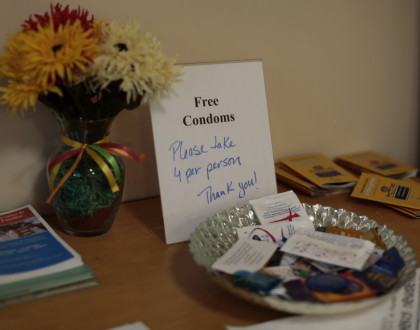National Condom Week – Check your knowledge!

On the final day of National Condom Week, take a moment to check your knowledge about safe sex and protecting yourself.
True or false?
1. Oil-based lubricants (i.e., petroleum jelly, shortening, mineral oil, massage oils, body lotions, and cooking oil) can be used on the outside of a condom.
False. Oil based lubricants should not be used with condoms because they can weaken latex, causing breakage. Water based lubricant only may be used on the inside or outside of a condom
2. A female (receptive) condom can be inserted up to two hours prior to sexual activity.
True.
3. If an individual is allergic to latex, they cannot make use of condoms during sexual activity.
False. Latex condoms, polyurethane condoms, and nitrile condoms (which female/receptive condoms are made of) have all been proven effective against STIs and pregnancy.
4. Using two condoms increases one’s protection against STIs and pregnancy.
False. Using two condoms is ineffective, as it can lead to breakage.
5. When used correctly and consistently, condoms are the most effective form of protection against STIs and pregnancy.
True.
6. Using a condom can decrease the effectiveness of birth control if taken simultaneously.
False. Condom use does not decrease the effectiveness of birth control. In fact, the use of both condoms and birth control is very common and encouraged for protection.
7. Condoms make me less sensitive.
False. Using a condom doesn’t have to spoil the moment. They can lengthen the time of sexual activity and they come in different sizes, shapes, and textures to suit individuals.
8. Condoms are not necessary during oral sex.
False. STIs such as herpes, chlamydia and gonorrhea can transmit through oral sex and settle in the throat. Thus, condoms during any form of sex (oral, anal, vaginal) is highly recommended.
Why does this matter?
- 65 million people in the U.S. carry a sexually transmitted infection and can pass it on to others at any point.
- Young people, ages 15-24, account for 25% of all new HIV infections in the U.S. and make up almost one-half of the over 19 million new sexually transmitted infections Americans acquire each year.
- One in four sexually active adolescent females have a STI, such as chlamydia or HPV.
- About 750,000 teens become pregnant in the U.S. each year, with up to 82% of those pregnancies being unintended.
Based on theoretical and empirical data, the consistent and correct use of condoms has proven to be an effective barrier against sexually transmitted infections, including HIV. In fact, condoms reduce a male’s risk of HPV and a female’s risk of HPV and cervical cancer, HPV being a treatable yet incurable virus that is common amongst nearly 90% of the U.S. population. In addition to this proven effectiveness, condom breakage rates in the U.S. are tracked to less than two percent, most of which can be accounted to incorrect use rather than the condom’s quality. Thus, in one year with perfect use, 95% of women relying on the female condom will remain pregnancy free and 98% of women relying on male condoms will remain pregnancy free.
What does correct use of latex condoms entail?
- Use a new condom for every act of vaginal, anal and oral sex throughout the entire sex act (from start to finish).
- After ejaculation, grip the rim of the condom and carefully withdraw, making sure that semen or vaginal fluids does not spill out.
- Wrap the condom in a tissue and throw it in the trash where others won’t handle it.
- If you feel the condom break at any point during sexual activity, stop immediately, remove the broken condom, and put on a new condom.
- Ensure that adequate lubrication is used during vaginal and anal sex, which might require water-based lubricants.
Where can I find out more about condoms and sexual health?
- Mayoclinic
- Advocates for Youth
- I Wanna Know
- Planned Parenthood
- Your local health center or hospital
References:
CDC (2013, March). Condom Fact Sheet In Brief.
Bridges, Emily (2014, May). Advocates for Youth: Sexuality Education.
Sue Alford (2005, September). Advocates for Youth: Condom Effectiveness.
CDC (2012). Sexually Transmitted Diseases Surveillance: STDS in Adolescents and Young Adults
